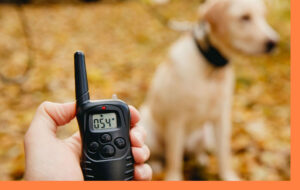Picture a world where talking to your dog is easy, where they happily follow your commands, and training together feels like a fun adventure. This is what every dog owner hopes for, and sometimes, it makes people think about using a shock collar.
You might have considered using a shock collar for your dog. But, before we talk more about it, let’s explore this topic together and make sure we understand it well. We want you can do what’s best for your furry friends.
Whether you’re simply curious or actively seeking guidance, we will provide a guide that will transform your understanding of dog training.
So, let’s delve into the world, of how to introduce a shock collar for dogs where responsible usage leads to harmonious companionship.
So, what exactly is a shock collar for dog?
A shock collar is a device made for dog training. It sends a small electric signal to your dog, sort of like a tiny zap, to help with training. It’s used to encourage good behavior and discourage bad habits.
But, it’s important to know that not all shock collars work the same way. There are different types with unique features designed for specific training needs.
Some shock collars use static stimulation, which is like a little electric buzz. Others use vibrations or even sprays like citronella or water. The type you choose should match your dog’s personality and the behaviors you want to improve.
The main goal of these collars is to correct your dog’s behavior humanely without causing harm or discomfort.
Are they safe, though?
That’s a good question. The safety of shock collars depends on responsible usage. While there are misconceptions, when employed correctly, they can be safe tools for dog training. It’s crucial to understand when and how to use them effectively and humanely to ensure your pet’s well-being during the training process.

At what age should you start using a shock collar on a dog?
When considering the appropriate age to introduce a shock collar, it’s generally advised to wait until your dog reaches around six months of age.
By this time, your furry friend should have a grasp of basic commands, making it easier for them to understand the purpose of the collar and respond to training cues effectively.
Starting too early may overwhelm them, so patience and timing are crucial for successful shock collar training.
Factors to Consider Before Collar Use for Your Dog
Introducing a collar to your dog’s life is a significant decision that comes with various considerations to ensure the well-being of your furry friend. Before you decide to use a collar, here are some essential factors to take into account:
1. Purpose of the Collar:
- Determine the primary goal of using a collar. Is it for identification, leash attachment, or training? Different types of collars serve different purposes, so clarity on your objectives is crucial.
2. Dog’s Age and Size:
- Consider your dog’s age, size, and breed. Puppies may require special collars, while larger or stronger breeds might need sturdier options. Ensure the collar you choose is suitable for your dog’s physical characteristics.
3. Collar Material:
- Collars come in various materials, including nylon, leather, and chain. Consider factors like comfort, durability, and hypoallergenic properties when selecting the material.
4. Safety Features:
- Safety should be a top priority. Look for collars with safety features like quick-release buckles to prevent choking hazards or reflective elements for visibility during nighttime walks.
5. Comfort and Fit:
- A well-fitting collar should be snug but not too tight. Measure your dog’s neck accurately to ensure a comfortable fit. Check regularly to accommodate any growth or changes in weight.
6. Training Needs:
- If you’re using a collar for training purposes, research the most appropriate type, such as choke collars, prong collars, or shock collars. Consult a professional dog trainer for guidance on the best training tools.
7. Allergies and Sensitivities:
- Some dogs may have skin allergies or sensitivities to certain collar materials. Be mindful of your dog’s skin condition and choose a hypoallergenic collar if necessary.
8. Local Regulations:
- Familiarize yourself with local laws and regulations regarding dog collars. Some areas may have specific requirements for collars, especially if your dog spends time in public spaces.
9. Personal Preferences:
- Your preferences as a dog owner matter too. Some people prefer stylish, personalized collars, while others prioritize functionality and simplicity.
10. Maintenance and Cleaning: – Consider how easy it is to clean and maintain the collar. Collars can get dirty quickly, so choose one that suits your willingness and ability to keep it clean.

How To Introduce a Shock Collar for your Dog?
Introducing a shock collar to your dog should be done with great care and responsibility to ensure both effective training and the well-being of your pet. Here’s a step-by-step guide on how to do it:
1. Choose the Right Collar:
Select a collar that fits well and is designed for your dog’s size and training needs. Ensure it’s comfortable and adjustable for a secure fit.
2. Learn How It Works:
Familiarize yourself with the collar’s functions, settings, and operation by carefully reading the user manual and instructions.
3. Basic Training First:
Before using the collar, teach your dog basic obedience commands like sit, stay, and come. This builds a foundation for effective training.
4. Get Familiar:
Allow your dog to wear the collar without activating it during enjoyable activities to help them get used to it.
5. Start with Low Settings:
Begin training with the collar set at the lowest intensity to ensure a mild correction and observe your dog’s response.
6. Combine with Rewards:
Use positive reinforcement, like treats and praise, alongside the collar to encourage desired behaviors and make training enjoyable.
7. Monitor and Adjust:
Keep a close eye on your dog’s reactions during training, and adjust the collar’s intensity gradually if necessary. Always prioritize your dog’s comfort and well-being.
Do Dogs Learn From Shock Collars?
The question of whether dogs can learn from shock collars, The answer is yes.
Dogs can learn from shock collars, but it comes with important caveats. When used appropriately and responsibly, shock collars can be effective tools for reinforcing commands and discouraging undesirable behaviors.
However, the learning process must be accompanied by positive reinforcement, such as treats and praise, to ensure that your dog associates the right behaviors with positive outcomes.
The key lies in using the collar as part of a comprehensive training regimen that prioritizes your dog’s well-being, emphasizing humane and ethical practices.
It’s also crucial to tailor the collar’s settings to your dog’s temperament and start with the mildest correction. While shock collars can play a role in training, they should never be used as a sole means of instruction or as a form of punishment.
Consulting with a professional dog trainer or behaviorist can provide valuable guidance on using shock collars effectively and responsibly to help your furry friend learn and thrive.
Conclusion
In conclusion, introducing a shock collar to your dog is a decision that demands careful consideration and responsibility.
It can be an effective training tool when used ethically and in conjunction with positive reinforcement.
Remember to prioritize your dog’s comfort, safety, and well-being throughout the training process.
If you’re not sure or have problems while training, it’s smart to ask a professional dog trainer or behavior expert for help.
The secret to making shock collar training work is to build a strong, loving bond with your dog.
Be patient, consistent, and use the collar responsibly. This way, you can have a better connection with your dog and make their behavior better.
Thanks For Reading Our Guide

